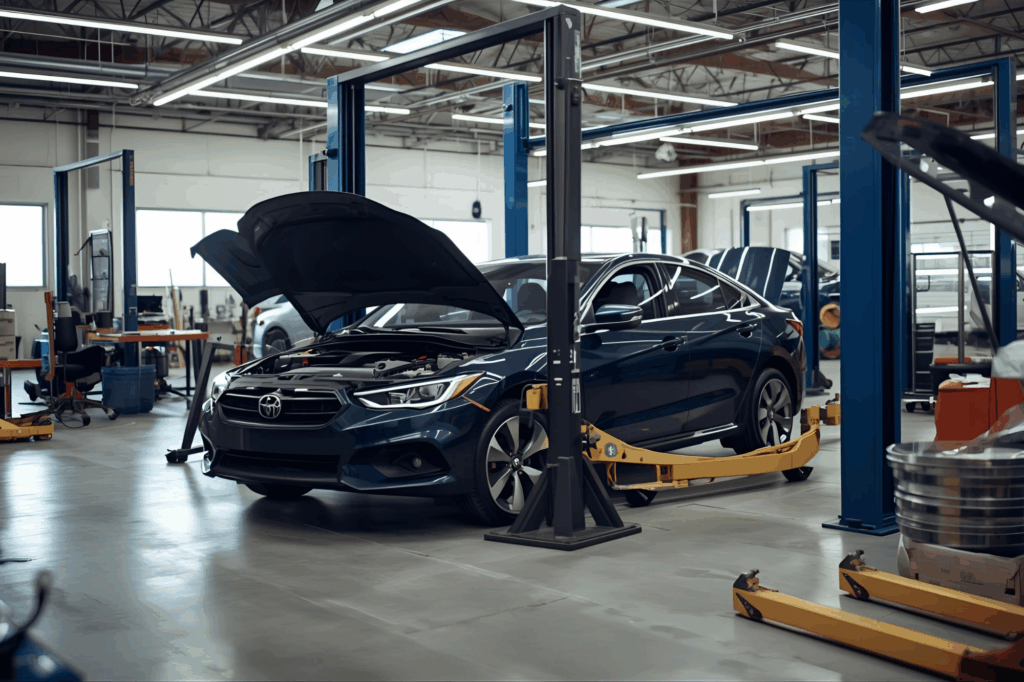We all know that the combination of substance abuse and addiction is major issue affecting a large number of people across our country. We see the stories about it in the media every day. Many of us know of friends, relatives, or acquaintances who suffer from its effects, either directly or indirectly.
As a result of its being a part of the larger world that we live in, your repair shop and its employees will represent both the good and the bad trends that exists in the larger society. This means that the substance abuse and addiction issues that plague the world outside your shop are very likely to enter your workplace, causing a wide variety of problems.
If not controlled or prevented, the fallout can affect your profitability, your staff culture, your insurance rates, your customer satisfaction levels, and even the survival of your business. What this means is that you must be vigilant against substance abuse and addiction in your shop, and you must also have a plan in place to deal with it, wherever and whenever it crops up. And it will crop up.
Let’s define the problem of substance abuse and addiction, its effects on your shop’s techs and staff, symptoms and signs of employee substance abuse and addiction, and some solutions that you can put into place to fight back against this terrible threat to lives and careers.
Defining the extent of the substance abuse and addiction crisis
Contrary to popular opinion, the average American who is a substance abuser and/or an addict is not someone who has passed out in an alley. According to the National Council on Alcoholism and Drug Dependence (NCADD), over 70 percent of American drug abusers and binge drinkers are employed. Many of them are functional enough to have successful careers. These people are certainly not in a good state of health, but they are often very good at hiding the outward appearance of their dependence.
From the early days of the 20th Century up through around 1980, the only drug of note (besides alcohol) that made it into public awareness was marijuana. Since then, we have seen cocaine, meth, heroin, MDMA, opioids, and many more, make their appearance in society and in the workplace. Now add the widespread abuse of prescription drugs, and you have an extremely complex situation for the average shop owner to deal with.
Let’s review some alarming statistics:
- 7% of full-time workers aged 18-64 used alcohol heavily in the past month,
- 6% used illicit drugs in the past month
- 5% were dependent on or abused alcohol or illicit drugs in the past year
- 79% of adult binge drinkers and 76% of adult heavy drinkers are either full-time or part-time employees
- 80% of drug users supported their drug use by stealing from their work
- Methamphetamine use has risen 64 percent between 2012 and 2016
- The cost of the opioid crisis has been estimated to be over $2.5 trillion for the four-year period from 2015 to 2018
- Drug abuse and addiction cost American companies $81 billion every year in absenteeism, healthcare costs, and lost productivity
- In 2017, there were 272 deaths from unintentional overdoses due to non-medical use of drugs or alcohol at work
- One-third of all employees are aware of the illegal sale of drugs in their workplace
- Alcohol is involved in over 10% of workplace fatalities
Specific problems faced by the independent auto repair business
These substance abuse and addiction-related issues affect both techs and your shop in a very negative way:
- Missed workdays
- Tardiness
- High turnover
- Higher health care costs from increased injuries and ER visits
- Increased legal costs
- Higher risk of accidents and worker comp claims
- Theft
- Drug sales in the workplace
- Lower morale among your sober techs
Opioids: a special category of major concern
The opioid crisis has been well documented and publicized for many years. It started when physicians were encouraged to prescribe these painkillers (which work in a similar way to heroin) in plentiful quantities, for nearly every medical condition that required pain relief. We now know that these drugs got millions of ordinary people addicted. In hindsight, the results were predictable – ruined lives, with many turning to and overdosing on street heroin or fentanyl when their prescriptions ran out and the cravings remained. The makers of these addictive and deadly drugs are just beginning to pay the price, but no amount of money will bring back the tens of thousands of victims who have already died. Thanks largely to the deadly effects of opioid addiction, a drug overdose is now the leading cause of death among Americans who are under the age of 50.
This remains a widespread public health crisis, and it may already have appeared in your shop. If one of your techs is injured, the doctor can still prescribe opioid painkillers as part of the treatment plan. What if that tech gets hooked? How will this affect the quality of his or her work? Will you be able to continue to employ that person? And with the labor market so tight, where will you find someone who is drug-free to replace the addicted tech you terminated? It’s a huge problem.
Legal marijuana: a new gray area
To make things even more complicated, medical and/or recreational marijuana is now legal in about two-thirds of all US states – and all of Canada. While marijuana advocates may tout its lack of negative side effects, pot does not mix well with the auto repair business. Studies have tracked much higher rates of accidents, injuries, and absenteeism in those who have tested positive for marijuana.
The general public supports the universal legalization of pot, but that doesn’t mean it’s a good idea to allow it in the workplace. “But marijuana is legal! What’s wrong with using it at work?” your techs may ask. You need to have the right answer, even before you hear the question.
Signs and symptoms of substance abuse and addiction in your shop
Substance abusers and addicts may be experts at hiding the outward signs of their problems, but there are still many ways to spot the signals of substance abuse and addiction.
Outward signs that your techs and staff may have a problem
The first hints that your techs or staff may have substance abuse and addiction issues often come from changes in their behavior. You may notice a variety of disturbing things happening in your workplace, such as:
- An increase in accidents
- Inconsistent performance and work quality
- An inability to concentrate and focus on the job at hand
- Requiring a lot more time to finish a job, missing deadlines
- Displaying poor judgment
- Increasingly in calling in sick, arriving late and leaving early
- Making lame excuses for inability to observe normal work hours
- Changes for the worse in personal appearance and/or hygiene
- Inappropriate behavior, mood swings, confusion, or paranoia
- Inability to speak clearly
- Falling asleep at work
- Personal financial problems
- Complaints from other employees
- Equipment or cash missing from the shop
Factors in the workplace that can encourage substance abuse and addiction
It is important to understand that certain aspects of the workplace can encourage your techs and other staff to lean in the direction of substance abuse and addiction. You have the power to alter these conditions so that your employees can avoid the downsides. They include:
- The availability of drugs and/or alcohol
- A shop culture that accepts alcohol and/or drug use
- Working conditions that are stressful, isolating, or boring
- Aggression of a physical or verbal nature
- Sexual harassment
- Behavior that is disrespectful
Solutions to substance abuse and addiction in your shop
First, let’s separate the legal aspects of substance abuse and addiction from the health care aspects. If your techs and other staff have broken any laws, or have stolen from you as a result of their dependency, that’s one thing. But beyond this, dealing with the consequences to the individual falls into the health care arena, where treatment and other options should be made available to the person who is suffering. But is there any way to keep substance abuse and addiction out of your shop, before it gets in and does its damage?
Commit to a drug-free policy in your shop
When your shop has a drug-free policy that passes all legal tests and has buy-in from your techs and staff, you are well on your way to getting a handle on this spreading scourge. Doing this will separate your shop from all the others who consciously or unconsciously hire employees with substance abuse and addiction issues. Let the other shops take on the problematic people, while you work to keep your shop free of them. You can also view this as a competitive edge, as the quality of your drug-free shop’s work improves while theirs is very likely to decline!
Keep in mind that a drug-free workplace requires some work – you can’t just announce it and walk away. Your policy needs to be in writing, it needs to be compatible with all applicable workplace rules and regulations, and it needs to be approved by an attorney. Your insurance company, health insurance provider, trade association, and state workers’ comp organization can also help.
Once your drug-free workplace policy is vetted and put into writing, it should be distributed to all of your techs and staff. Each one should acknowledge that he or she has read it and understands what it means. This should be followed up with training that will allow your employees to understand the hazards of substance abuse and addiction in their workplace, and to identify the signs of it. Emphasize that this is a health and safety issue, and that any symptoms that they notice need to be reported promptly to management.
The final step is to have support services available when one of your employees shows the signs of substance abuse and addiction. Your shop’s health insurance plan should include counseling and treatment options that can give the affected people a chance to overcome their problems. There are also resources in the community (including Alcoholics Anonymous and Narcotics Anonymous) that can help your employees with their recovery post-treatment.
Pre-test all employees before you hire them
A good starting point to stem the tide of substance abuse and addiction in your workplace is to institute a pre-employment testing program. Be sure to mention this when applicants inquire, apply, or interview for jobs in your shop. This will likely eliminate many candidates who are already using and abusing, while sending a positive message to those who are not.
Institute a periodic random testing program
To maintain the integrity of your drug-free workplace, the pre-employment testing should be backed up with periodic and random testing of all employees. Doing this should let you deal with any substance abuse and addiction issues that may crop up over time among your existing techs and staff.
Substance abuse and addiction is a part of today’s workplace – how will your shop deal with it?
An effective approach to dealing with substance abuse and addiction in your shop requires equal parts of awareness, understanding, resolve, and compassion. When your techs and staff struggle with substance abuse and addiction issues, it becomes your problem to try and resolve. The quality, reputation, and profitability of your shop are at risk, but so are your people. Remember that identifying substance abuse and addiction is the first step, but by helping your techs and staff to overcome it you create a win-win, for them and for you!



